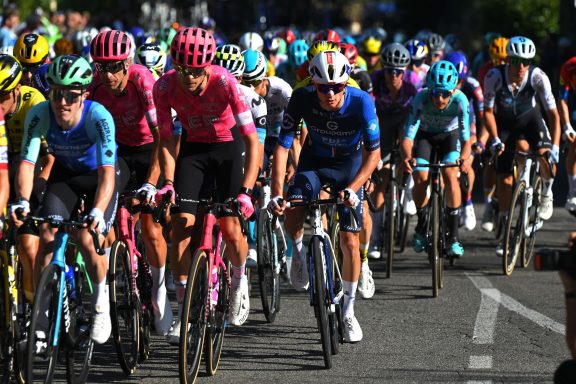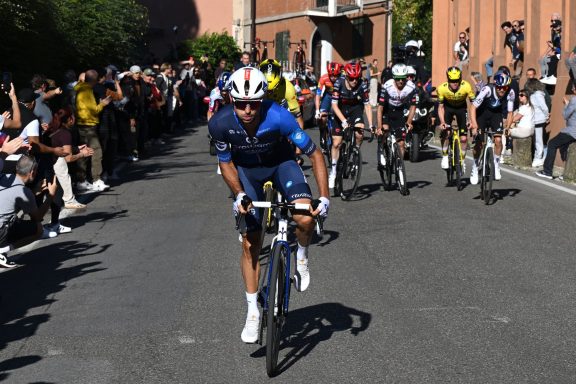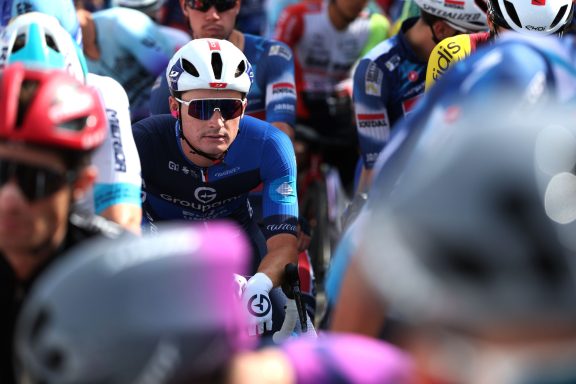Joshua Golliker definitely feels at home in the Aosta Valley. A year after his two victorious solos in the Italian region, the Briton did it again on Friday in the 2024 edition. After joining the breakaway on stage 3, the 20-year-old got over the climbs of Verrogne and San Carlo before taking the win, following a tremendous effort, in Pré-Saint-Didier. His first win of the season, a much awaited one, and the sixth for “La Conti”.
Apart from the national championships, it had been more than a month since “La Conti” had been on a start line. On Wednesday, the French continental team opened the second part of the season in the Giro Ciclistico della Valle d’Aosta-Mont Blanc, a race where it often proved successful. It all started with a first stage between Saint Gervais Mont Blanc and Passy. “The first day was a bit special, with only forty kilometres of racing and a sole climb of 10 kilometres at 6%,” said Jérôme Gannat. “Colin joined a breakaway group, but they tackled the final climb with only twenty seconds of a gap. The peloton was still made of around forty riders six kilometres from the summit, and that’s where Kazakhstan’s Dostiyev attacked. He finished solo, and Max Bock took a good twelfth place. It’s very good for him. After a difficult start to the season, he finally found a race that suited him, and that was important for his confidence.” The second stage, with “only” 2000 meters of elevation gain on the menu, went to the breakaway on Thursday. A large peloton of seventy riders, including Max Bock and Maxime Decomble, finished just twelve seconds behind in Borgofranco d’Ivrea, after 127 kilometres of racing.
“This victory means a lot,” Joshua Golliker
Distanced during this second stage, Joshua Golliker was however ready to attack on Friday between Sarre and Pré-Saint-Didier, for the first real test in the mountains. “He found himself in front after fifteen kilometres, but there were only three riders in the break, and they were still going fast behind,” explained Jérôme Gannat. “Then four other riders attacked from the peloton after around thirty kilometres, so it made a break of seven, and the peloton really eased off.” With no one being dangerous on GC up front, the yellow jersey even let the gap reach eight minutes in the first part of the race. After sixty kilometres, the climbs started. “In the Col de Verrogne, Joshua quickly got away with Guillermo Juan Martinez,” said Jérôme. “They were the strongest of the group. They climbed this pass quite fast even if it went quick also in the peloton where there were only thirty riders left, including Max and Maxime”. “I was told that the Colombian was the only very strong rider in the group, so I told him: let’s go together, let’s try and see what happens,” Joshua explained. The two men therefore got clear, and it quickly became obvious that they would contest the victory.
From then on, each one of them thought he had it. “In the descent from Verrogne, which was quite technical, Joshua dropped Martinez for the first time,” said Jérôme. “They got together again just before the San Carlo climb (10km at 10%). There, Martinez was stronger than Joshua.” “This climb was really hard,” said the Briton. “I thought I had lost it when he attacked me, but I thought that if I could hold on until the top, I could catch him on the descent”. Half a minute behind at the summit, the Briton did catch the Colombian on the downhill, and even left him behind, which meant he could tackle the final climb of Pré-Saint-Didier with twenty-five seconds of a gap. “The last climb was probably the hardest of the day because I had to dig really deep to get to the finish line,” said Joshua. “He really dug deep, both mentally and physically, to make sure Martinez wouldn’t come back,” added Jérôme. After the last 600 metres averaging 12%, the Briton managed to keep a small gap. He therefore took the win and let his joy explode. “I was really, really happy and really overwhelmed because I had a really difficult year,” he said. “This victory means a lot.”
“It will give him good momentum”, Jérôme Gannat
“He’s a specialist of these breakaways on the Giro della Valle d’Aosta,” said Jérôme. “We know that he cannot follow the best if he stays in the peloton, so he must anticipate and then try to stay away in the climbs. He is very strong in this type of scenario. As I said before, he is often better when he’s alone than when he’s with other riders. This Giro della Valle d’Aosta was an important moment of the season for him because this is where he stood out last year and it is a decisive turning point for the rest of the year. Until then, we had not yet seen last year’s Joshua. It’s good for him, it will give him good momentum for the second part of the season and in particular for the Tour de l’Avenir which he will compete with Great Britain.” Also, “La Conti” ideally resumed the season, and Max Bock, sixteenth on Friday, now sits ninth overall. “We must also highlight the good work done in the Aosta Valley two weeks ago with a training camp,” concluded Jérôme. “I think it bore fruit and proved necessary to start the second part of the season with good fundamentals. The goal now is for Max Bock to stay in the top 10. It would be a good performance for him. Besides that, the others will be able to continue chasing the stages.”



